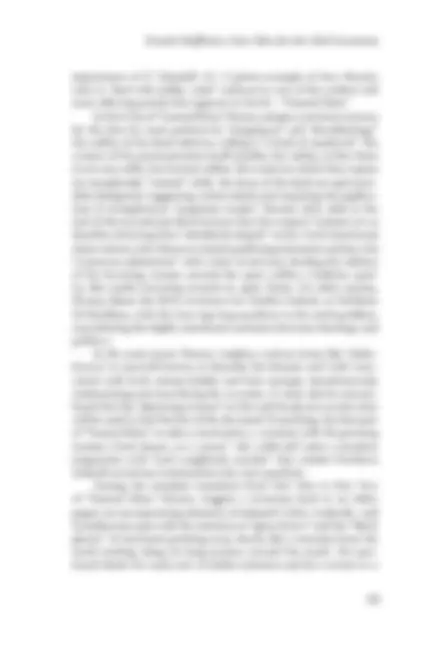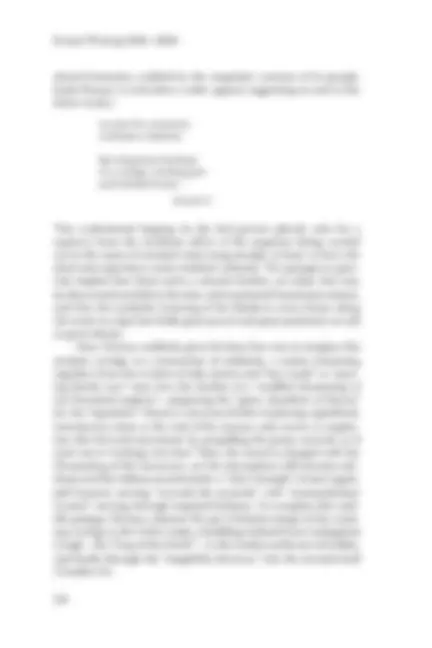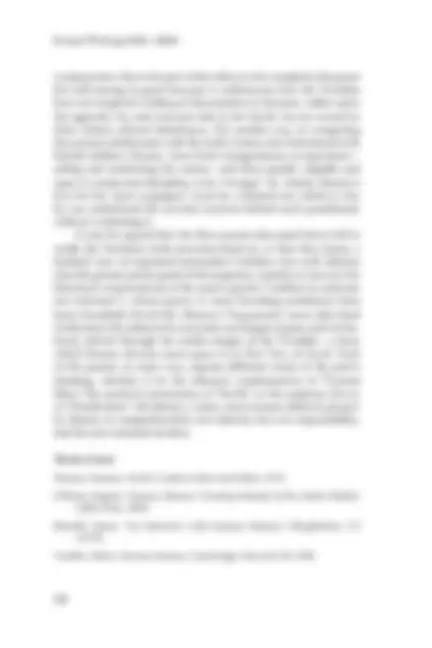






Study with the several resources on Docsity

Earn points by helping other students or get them with a premium plan


Prepare for your exams
Study with the several resources on Docsity

Earn points to download
Earn points by helping other students or get them with a premium plan
Community
Ask the community for help and clear up your study doubts
Discover the best universities in your country according to Docsity users
Free resources
Download our free guides on studying techniques, anxiety management strategies, and thesis advice from Docsity tutors
Seamus Heaney's 'North' is a collection of poems that contextualizes, historicizes, and mythologizes the struggle in Northern Ireland during 'The Troubles'. Heaney resists simple endorsement of Irish history as justification for contemporary aggression and instead views cultural memory as contingent. The poems attest to an inexorable cycle of violence and mourning, sacrifice and solitude, law and ceremony, death and life. Heaney's artistic virtues lie in his slow and deliberate task of unearthing the past to bring new forms of understanding to light.
What you will learn
Typology: Study notes
1 / 8

This page cannot be seen from the preview
Don't miss anything!





Writer’s Comment: I wrote the following paper for Alan Williamson’s post- World War II British literature class this past spring. Prof. Williamson’s class proved to be an insightful and ambitious romp through the rampant anxiety and mordant humor that has marked the postmodern condition, touching upon many of the key works that shaped it in different and meaningful ways. My decision to write on Seamus Heaney’s poetry is one that I had been stew- ing over for quite some time beforehand. Like many others, I enjoyed Heaney’s Beowulf a great deal, and after hearing Heaney speak several years ago, I was struck by his reverence for the past and his hope in its value as a guide for the future. Every race and every civilization has a story to tell or a song to sing, but for whatever reason, I have always been drawn to the tragedy and laugh- ter of Irish culture, foremost. In North, Heaney tells that story with great care, preserving it in his poetry as the earth did the figures about which he writes. As a Catholic of Northern Irish stock, born during the Troubles, I felt a con- nection with these poems and shared a very strong need to get it right as well. —Daniel Hoffheins Instructor’s Comment: Daniel Hoffheins is the kind of student any profes- sor would be delighted to have, especially when running a large class as a mix- ture of lecture and discussion. He sat in the front row; participated eagerly; and brought a sophisticated background knowledge of English literature to bear. So I wasn’t surprised when he chose the option of developing his own paper topic, rather than simply responding to an assigned prompt. Daniel’s paper expands (widely!) on a class discussion of Seamus Heaney’s interest in ritual, his recog- nition that more than rational “arbitration” is needed to “placate” the “tribal” hatreds in Northern Ireland. His lucid style, close reading skills, and moral seri- ousness delighted me; I hope they will delight others. —Alan Williamson, English Department
Prized Writing 2005–
ritten during the height of “The Troubles” in Northern Ireland in the 1970s, when the violence that had marked the Irish independence movement during the first quar- ter of the 20th century had re-detonated, Seamus Heaney’s North contextualizes, historicizes, and mythologizes the struggle in an effort to cast serious doubt upon the possibility of unmitigated moral triumph by either Catholics or Protestants. The poems in North also attest to an inexorable cycle of violence and mourning, sacrifice and solitude, law and ceremony, death and life—what Heaney would call “the matter of Ireland.” Heaney resists any simple endorsement of Irish history as justification of contemporary aggression; rather, the poet views cultural memory as contingent, and history more as the experience of victimization and less as a chain of supposedly mean- ingful events, i.e., kings and battles. Heaney is a sensitive cultural archaeologist, using his poetry carefully and meticulously to recog- nize the voiceless and forgotten. The artistic virtues of North (and they are many) lie in this slow and deliberate task, in the modern expectation that, by unearthing the past, new forms of understand- ing may come to light—at the same time Heaney also digs inward, saying as much about himself as he does about his fellow Irishmen. Throughout most of Part One in North, Heaney demurs from poeticizing the more lurid aspects of the Troubles, preferring to contemplate the violence obliquely and relying on the minutiae of ritual to reveal untapped truths. It was his discovery of P.V. Glob’s The Bog People, together with the incessant coverage of the violence in Northern Ireland, that provided the pivotal symbolic spark for Heaney’s imagination, crediting his Irish fondness for remembering the past rather than looking to the future for answers (O’Brien 22). One of his most powerful metaphoric strategies—the use of bog references as a means of slow discovery—struck home because it provided plausible, germinal clues as to how, after a period of rela- tive peace, so much polarized sectarian hatred could suddenly rise up (again) and terrorize Ireland. What precedents, Heaney asks, explain this unshakable, almost visceral, adherence to Irish sec- tarianism? Heaney, in discussing the complex relationship between poetry and politics, remarked that “you deal with public crisis not by accepting the terms of the public’s crisis, but by making your own imagery and your own terrain take the color of it, take the
Prized Writing 2005– shared humanity, codified by the unspoken customs of its people, leads Heaney to articulate a sober appeal, suggesting an end to the bitter rivalry: we pine for ceremony, customary rhythms: the temperate footsteps of a cortège, winding past each blinded home. (North 7) This confessional longing (in the first-person plural), asks for a reprieve from the invidious effect of the pogroms being carried out in the name of national unity, long enough, at least, to bury the dead and experience some residual catharsis. The passage in ques- tion implies that there exists a natural rhythm, an order, that may be discovered and felt in the slow and mannered funeral procession, and that the symbolic lowering of the blinds in every home along the route is a sign that holds great power and great potential, as well as great shame. Next, Heaney suddenly gives his lines free rein to imagine this modern cortège as a restoration of solidarity, a nation streaming together from the rivulets of side-streets and “bye-roads” as “purr- ing family cars” tune into the rhythm of a “muffled drumming of ten thousand engines”—preparing the “great chambers of Boyne” for the “sepulchre.” Heaney’s structural habit of placing capitalized, introductory lines at the end of his stanzas only serves to empha- size this forward movement by propelling the poem onward, as if each one is “nos[ing] into line.” Here, the mood is charged with the thrumming of the mourners, yet the atmosphere still remains sub- dued, and the tableau anachronistic: a “slow triumph” of men (again, pall bearers) moving “towards the mounds” with “somnambulant women” moving through emptied kitchens. To complete this mid- dle passage, Heaney conjures the pre-Christian image of the wind- ing cortège as the Celtic snake, straddling Ireland from Carlingford Lough—the “Gap of the North”—to the tombs northwest of Dublin, and finally through the “megalithic doorway” into the mound itself (Vendler 53).
Daniel Hoffheins, New Skin for the Old Ceremony Part Three of “Funeral Rites” elaborates upon the confessed desire for a unifying ceremony in Part Two by advocating that a feud may, indeed, go unavenged: die off with both warring factions mollified. As his literary/historic model, Heaney presents Gunnar Hamundarson from Njal’s Saga, whose death, it was decided, did not require bloody retaliation (Vendler 53). Far from the tradi- tional angry mound-warrior, greedily guarding his horde, Heaney presents Gunnar as “beautiful,” “chanting verses about honor,” and joyfully facing the moon, a vision of contentment and atonement. Moreover, four lights burn in the corner of his chamber, represent- ing, perhaps, the four unified provinces of Ireland in stark contrast to the earlier scene where coffin lids and macabre, hovering women filled the death chamber. On the one hand, Heaney argues for the integrity of cultural practice to preserve communal solidarity, and on the other he questions practices such as the holmgang (men- tioned in “Summer 1969”), which was a practice of dueling to sat- isfy a grievance while spawning a new one. Heaney’s overt intention in “Funeral Rites” appears, ultimately, not to deliver an angry jer- emiad, but rather to explain somehow the obstinacy of entrenched Irish beliefs, and to promote healing through the refutation of the very possibility of a term as horrific and absurd as “neighbourly murder.” As might be expected, in the title poem, “North,” Heaney relates the epiphany that engendered many of the poems in the volume and reports the oracular words of wisdom, given to the poet by the susurrus voices of the past which he labors to translate and inter- pret. Interestingly, Heaney plays the role not of the elegiac patholo- gist, here, but of the poet-quester, willing to accept enchantment but returning to the hammered strand only to find “the secular powers of the Atlantic thundering”... the “unmagical invitations of Iceland.” There is a sense that the poet has returned for guidance, for some deeper voice to resonate with understanding; however, he registers disappointment and loss with the silent prospect of “the pathetic colonies of Greenland.” Luckily for the poet and reader, the Viking dead, “those fabulous raiders” lying under Dublin or the hillsides of the Orkney Islands, do speak to him and reveal their marvelous stories.
Daniel Hoffheins, New Skin for the Old Ceremony tice, expanding it as a metaphor for the larger, centuries-old cultural approval of violence. Unlike the shocking intrusion of contempo- rary terror at the end of “The Graubelle Man,” Heaney immediately inserts himself as first-person poetic observer in the opening —“I can feel the tug”—addressing the young woman, the “Little adulter- ess,” in the second person. In the first six stanzas, Heaney deploys terse, alliterative observations which convey the woman’s nakedness while he clothes her with a lavish series of symbolic images: a horse being led, swinging jewelry, a ship’s rigging, a young tree, a field of corn, and, lastly, her noose is likened to a ring around the “brain-fir- kin” that stores “memories of love.” Heaney’s method through these initial stanzas is proleptic, developing sympathy for the already punished adulteress before returning to the past that led up to her death. For example, Heaney hints, in his description of her petrifac- tion, that she became a sapling like a chaste nymph, rather than be ravished. But Heaney does not arrogate the punisher’s right to pass judgment, condemn, or act. Surprisingly, in the climactic moment of ambivalent honesty, Heaney joins them in their tribal practice, acknowledging the sanctity, strength, and place of ritual. In the same poem Heaney pities the “undernourished,” “beauti- ful,” “poor scapegoat,” though he acknowledges—at one and the same time—that he would cast the “stones of silence” at her. His profession of love, like the “kind of manhood” he mentions in “Funeral Rites,” is qualified; he “almost” loves her because he cannot relinquish his role as “the artful voyeur.” The poet stands accused of silent (“dumb”) conformity in the ninth and tenth stanzas; however, his position is necessarily liminal and conflicted: he assumes the dual identity of the empirical scientist, labeling bones, and the poetic chronicler, numbering syllables. Not until the last stanza does Heaney invoke both aspects of his nature: the outraged observer, who actually feels the tug, and the assenting witness, who understands the erotically tinged intimacy of the punishment. Crucial to the poem’s underly- ing support of the punishment of the title is exactly this sense that the punishment is “intimate”—that it is “revenge”—and that its per- formance enacts a consummation of sorts. The stripping off of garments, the shaving of the “flaxen” hair, and the tarring of the body are all imbued with the same perverse symbolic logic. Heaney recognizes, despite his presumed “civilized”
Prized Writing 2005– compunction, that to be part of the tribe is to be complicit; the poem fits well among its peers because it underscores how the Troubles have not inspired a feeling of deracination in the poet, rather quite the opposite: he, and everyone else in the North, are too rooted to their violent cultural inheritance. Put another way, in comparing the ancient adulteresses with the Irish women who fraternized with British soldiers, Heaney views both transgressions as equivalent— aiding and comforting the enemy—and thus equally culpable and open to communal discipline, even “revenge.” So, clearly, Heaney’s love for his “poor scapegoat” must be a limited one which is why he can understand the atavistic motives behind such punishment without condoning it. It may be argued that the three poems discussed above fail to tackle the Northern Irish atrocities head-on, or that they betray a kindred view of repressed nationalist Catholics, but such debates miss the greater poetic goals of the sequence, namely, to uncover the historical consciousness of the poet’s psyche (“neither an internee nor informer”), whose poetry is more brooding meditation than hasty broadside (North 68). Heaney’s “bog poems” never skirt hard truths since the subjects he excavates are images of pain and victim- hood, relived through the media images of the Troubles—a facet which Heaney devotes more space to in Part Two of North. Each of the poems, in some way, exposes different strata of the poet’s thinking, whether it be the inherent condemnation of “Funeral Rites,” the mystical communion of “North,” or the expiatory fervor of “Punishment.” All inform a vaster, more mature dialectic project by Heaney to comprehend his own identity, his own responsibility, and his own national sacrifice. Works Cited Heaney, Seamus. North. London: Faber and Faber, 1975. O’Brien, Eugene. Seamus Heaney: Creating Irelands of the Mind. Dublin: Liffey Press, 2002. Randall, James. “An Interview with Seamus Heaney.” Ploughshares 5. (1979). Vendler, Helen. Seamus Heaney. Cambridge: Harvard UP, 1998.